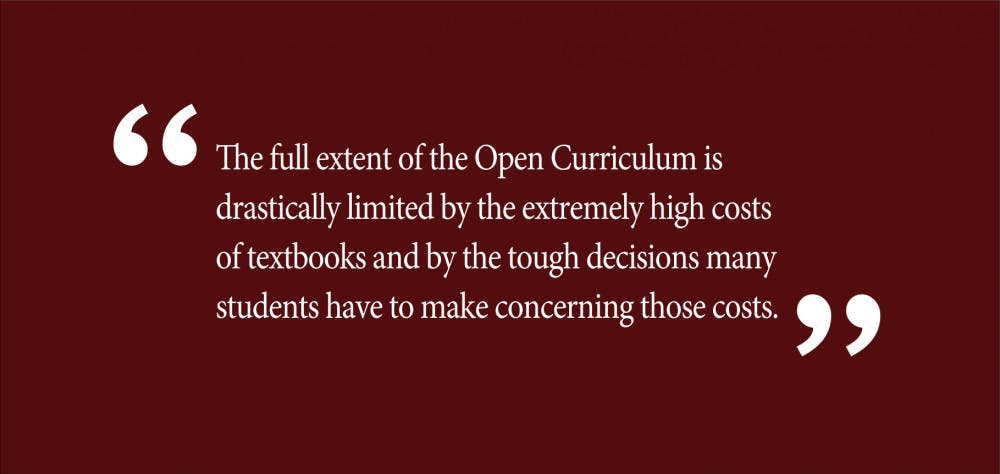Shopping period has now wrapped up around campus and, in its wake, it leaves a significant amount of financial woes for some students. With the absurd costs of books and the sheer number required by some professors, students may have to choose their courses based on finances, not their actual interests. The Open Curriculum is supposed to allow students to explore whatever courses are offered at the University. In theory, when choosing a course, students should primarily take into account their interest in the subject, their desire to explore a new area or how the course will contribute to their overall educational or preprofessional goals. They should not have to consider the financial burdens that a particular course would entail, especially after paying tuition. The full extent of the Open Curriculum is drastically limited by the extremely high costs of textbooks and by the tough decisions many students have to make concerning those costs.
I’ve experienced first hand the financial constrictions of the purportedly “Open” curriculum. This semester, I decided to leave my comfort zone by taking a new language, German, which I don’t see as adding professional value to my undergraduate education; but nevertheless, it sparked my intellectual curiosity. After the first couple of classes, I was hooked. I was thrilled by the idea of learning a new language from the very basics again and thereby gaining access to a new cultural perspective. The keyword of that sentence is “was”. My excitement waned significantly once I saw the cost of the online textbook. I still wanted to take the course because by this point I had already committed excessive time to keeping up with the course load. But I was hesitant to make such a financial commitment to a course on which I was already taking a big academic risk. When talking about this problem with my mother, who was already perplexed by my out-of-nowhere interest in German, I felt a strong sense of guilt. I was privileged enough to end up sticking with the course anyway, but many students would have lacked such privilege, and no one should have to feel guilty for exploring a new academic interest.
Brown currently has a few programs in place to cover the cost of textbooks for students who demonstrate the highest level of need, but these programs are inadequate because they do not extend to all students who are financially pressured by the cost of textbooks. “Emergency-Gap Funds,” a grant given through the UFunds portal, can cover textbook costs when they exceed $1632 per semester or when “no additional resources are available.” But that bar for support is too high. The costs of textbooks is still a burden, even if under $1600. Yet many professors think E-Gap is sufficient for their courses and put little effort into alternative solutions.
Brown seemed to recognize the failings of E-Gap Funds when it implemented a pilot program last year to cover the full cost of textbooks for 85 first-year students who are on full financial aid. This year the program was expanded to first-years who received various levels of financial aid and students of other years who are on full financial aid, amounting to approximately 1,100 students. Though this program is a big step in the right direction, it is still not enough to assist all the students on campus with financial need. For example, the program favors first-years, who do not necessarily have greater financial need than the rest of the student body. In future years Brown should expand this program to cover the needs of the entire student body equally.
Some professors do find innovative solutions to help cover the cost of textbooks, but these are inconsistent and unreliable. I was able to afford my German course because another professor decided to cover the entire cost of his class for me, leaving me with extra money for the German textbooks. While I greatly appreciate his generosity, I should not have to rely on the arbitrary whim of an unusually generous professor. We need, instead, a standardized and adequate program in place to manage textbook costs that would relieve all of the stress placed on students and streamline the process.
If Brown continues to fail to provide adequate learning resources for its student body, the school is not living up to the promises of its own Open Curriculum. There is no Open Curriculum until every student has the ability to take every course — and that ability remains impossible without further textbook funding. Until Brown expands the scope of these programs or offers better alternatives, it is fair to say that the Open Curriculum is a feature of Brown University accessible only to wealthier students.
Alisa Caira ’22 can be reached at alisa_caira@brown.edu. Please send responses to this opinion to letters@browndailyherald.com and op-eds to opinions@browndailyherald.com.





